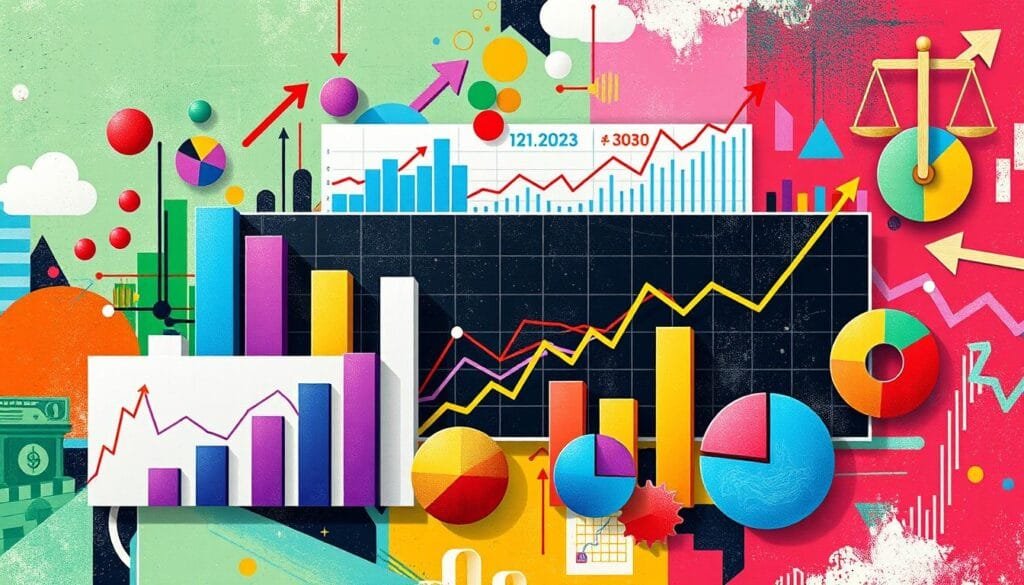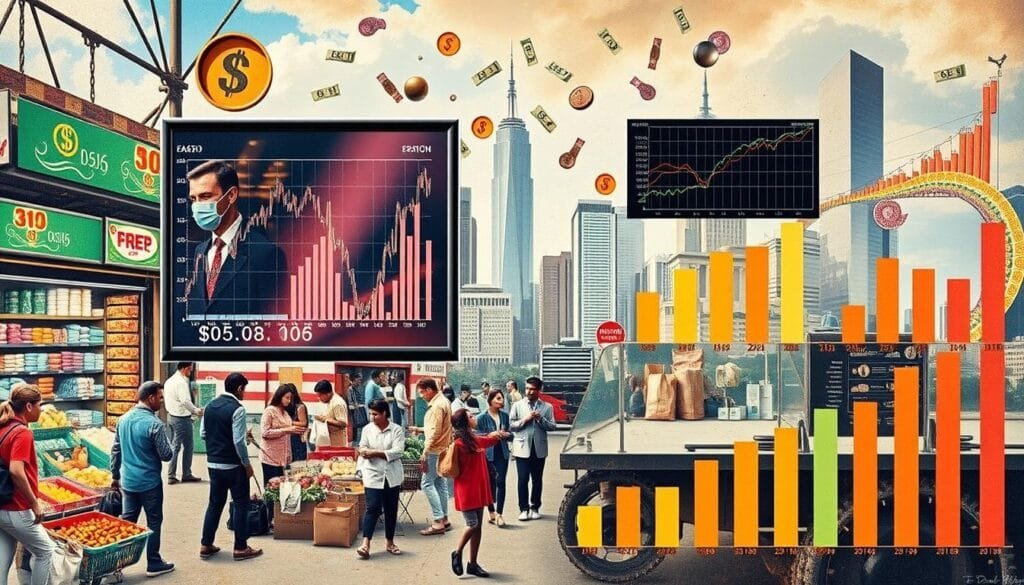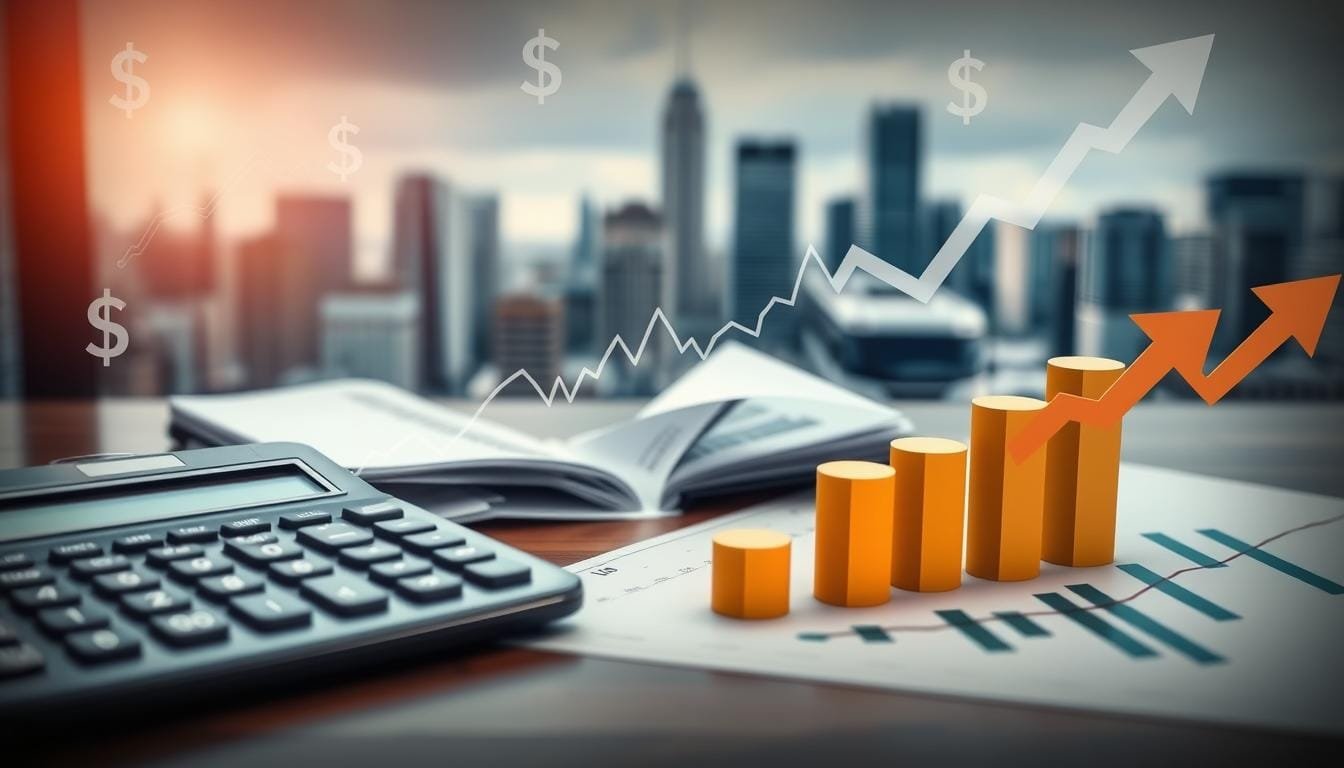Have you ever wondered about a simple number showing living cost changes? It also impacts national economy policies. Learning how to calculate the price index is essential for anyone studying economics. Our guide makes this concept clear for economists, students, and professionals.
We will cover the basics you need to understand price indexes. You’ll see how historical data, like the Consumer Price Index (CPI) from the 1982-84 period, helps gauge inflation. An index value of 110 means prices have gone up by 10%, and 90 means they’ve decreased by 10%. Knowing this is crucial for working with economic indicators and tracking inflation.
Let’s explore the various price indexes, how to calculate them, and the challenges involved. By the end of this guide, you’ll confidently use this economic tool in your analyses.
Key Takeaways
- Understanding the role of the Consumer Price Index (CPI) in economic analysis.
- Importance of market basket composition in CPI computation.
- Insight into the U.S. Bureau of Labor Statistics (BLS) methodology.
- Real-world applications of price indexes in measuring inflation.
- Challenges faced in data collection and accuracy in price index measurement.
- The influence of CPI on financial planning and policy-making.
Understanding Price Index and Its Importance
A price index is key in economics. It shows how the costs of goods and services change over time. This reveals trends in inflation or deflation, showing us the economic health.
Definition of Price Index
To grasp what a price index means, look at how it’s calculated. It compares the present cost of goods to their cost in a past reference period. Specifically, the Consumer Price Index (CPI) looks at average prices of consumer items. These items vary in importance in a consumer’s budget. In 2020, the CPI was at 142.86. This means a 42.86% increase in costs since 2010.
Why Price Index is Crucial in Economics
Price indexes matter greatly in economics. They guide policy decisions. For instance, Social Security’s recent big cost-of-living increase was CPI-based. Changes in CPI affect wages, pensions, and rents. They also help in tracking inflation, with a current CPI rise of 2.7%.
Price indices analysis helps eCommerce understand the market. It aids in capturing accurate pricing data. This knowledge allows for better revenue and pricing strategies. Understanding price indices is vital for informed economic choices.
Different Types of Price Indexes
It’s key to understand the different price indexes for solid economic tracking. Each one shows unique things about inflation and price changes. They help guide policy and economic forecasts.
Consumer Price Index (CPI)
The Consumer Price Index (CPI) is a well-known price index. The U.S. Bureau of Labor Statistics calculates it monthly. It watches the cost changes for a basket of consumer goods and services over time.
The CPI started in 1913. It uses price averages from 1982 to 1984 as a base, set at 100. For example, a CPI of 175 shows inflation has increased by 75% from the base year. This index is crucial for watching inflation and adjusting wages. It helps us match the economic changes.
Producer Price Index (PPI)
The Producer Price Index (PPI) looks at selling price changes for domestic producers. It’s good for seeing quick price changes from makers. The PPI offers insights from the producer side. It shows how inflation influences production costs and the economy’s health.
GDP Deflator
The GDP Deflator gives a wider view of inflation than CPI. It compares current and past prices of all domestically made goods and services. This index tweaks GDP for inflation, giving us a true view of growth. The GDP deflator sees prices for all GDP parts, offering a broad perspective for analysis. For instance, it helps adjust real wages, linking wages to inflation closely.

In short, the CPI, PPI, and GDP deflator are key for economic tracking. They highlight various price changes and inflation parts. This enables us to understand and react to economic changes well.
How to Calculate Price Index in Economics
Understanding how to calculate the price index is key. It shows how the cost of a market basket changes over time. We use economic formulas and take specific steps. This includes looking at how different data points work together. Here we’ll explain the formulas and steps with example calculations for easier understanding.
Basic Formula for Price Index Calculation
The core formula for price index looks like this:
Price Index = (Market Basket in current year / Market Basket in base year) x 100
Imagine in 2006, the market basket was $250. By 2007, it rose to $300. So, the calculation goes:
Price Index = ($300 / $250) x 100 = 120
Step-by-Step Guide
- Gather data on the goods in the market basket and their prices for both years.
- Figure out the total spending for the base year.
- Do the same for the current year.
- Deploy the price index formula: (Market Basket in current year / Market Basket in base year) x 100.
- Understand the result to see the cost change percentage from the base year.
Worked Example
Let’s break down a real-life case to grasp the price index calculation better. Below are the details:
| Items | Quantity | Price in 2006 | Price in 2007 | Expenditures in 2006 | Expenditures in 2007 |
|---|---|---|---|---|---|
| Shirts | 10 | $10 | $12 | $100 | $120 |
| Pants | 5 | $20 | $25 | $100 | $125 |
| Bread | 100 | $0.50 | $0.55 | $50 | $55 |
| Total | $250 | $300 |
Next, we use our data with the price index formula:
Price Index = ($300 / $250) x 100 = 120
It shows a 20% rise in the cost of the market basket from 2006 to 2007.
Common Challenges in Calculating Price Index
Calculating the price index involves several difficult steps. Each step has its own set of challenges. These include collecting data, adjusting for changes in product quality, and calculating inflation. It’s crucial to pay close attention to these aspects and strive for better methods.

Data Collection Issues
Gathering accurate data is key for calculating price indexes. But, economists run into several problems:
- The Consumer Price Index (CPI) takes about 80,000 price quotes every month. Still, it misses about 7% of the U.S. population. This mostly affects data on suburban and rural areas.
- The Bureau of Labor Statistics (BLS) added room air conditioners to the CPI goods basket in 1964. But, their common use began in the early 1950s. This shows the timing challenge in collecting data.
- Collecting data from different places like stores, rental spaces, and services makes the CPI more complex and possibly less accurate.
Variations in Product Quality
Adjusting for product quality when calculating price indexes is a big challenge. These adjustments are crucial for accurate economic insights:
- New and better products affect the price index. For example, VCRs and personal computers were added to the CPI in 1987, although they were popular much earlier.
- For tech products, quality adjustments look at improvements in speed, memory, and screen size.
- Sometimes, the CPI misses improvements in product quality. This affects how we view consumer spending, despite price hikes.
- Shrinkflation is another issue. It’s when the product size gets smaller but the price stays the same.
Inflation Adjustments
Correctly measuring inflation involves looking at many economic factors carefully. Here’s why it can be challenging:
- The CPI doesn’t adjust for new products or similar goods substitutions. This affects its real inflation rate accuracy.
- The CPI’s fixed basket of goods can exaggerate the actual cost of living.
- By the early 2000s, it was thought the CPI showed a 0.5% yearly inflation rate overestimate.
- Even when energy and grocery prices soared, the CPI showed a modest inflation. This reveals a mismatch.
| Category | Challenges in Economics |
|---|---|
| Data Collection | Gaps in coverage, timing issues, diverse sources |
| Quality Adjustments | New products, technological improvements, shrinkflation |
| Inflation Measurements | Fixed basket assumptions, overstatement of cost of living |
Practical Applications of Price Indexes
Price indexes are crucial in many fields, helping in economic decisions and policy making. Governments use them to guide policies, predict the economy, and control money flow. For example, central banks like the Federal Reserve watch consumer and producer price changes. They do this to set goals for inflation, important for keeping the economy stable.
Companies use price indexes to plan and position themselves in the market. By observing price changes, they can set accurate prices and adapt to market changes. Price data lets companies plan for higher costs and adjust their prices to maintain profits.
Inflation rates, like the book price rise from $20 in 2016 to $20.50 in 2017, show how CPI helps us see economic trends.
Researchers and economists analyze price indexes to learn about income and poverty levels. These studies help us understand how affordable goods and services are in different areas. They let us compare prices and find differences between places.
The Consumer Price Index (CPI) and measures like Trimmed Mean Inflation give us vital data for financial analysis. For instance, investors pick specific sector price indexes to spread their investments. They do this to protect their money from inflation with tools like TIPS.

- CPI-based clauses in contracts help adjust wages or payments, matching inflation.
- Housing price indexes affect real estate choices, changing mortgage rates and how affordable homes are.
- Changes in rental price indexes lead to rent adjustments, affecting both renters and landlords.
Social security, pensions, and annuities often change with inflation thanks to CPI. Retirees get these changes to keep their buying power, as the COLA does for public workers.
In the end, policymakers look at price indexes to judge how well economic policies work. By comparing price changes before and after policies, they can see if adjustments are needed. This ensures policies achieve their economic goals.
Conclusion
This guide has shown the importance of price indexes like the CPI, PPI, and the GDP Deflator in economics. They help us understand how price changes affect consumers and producers. These indexes are key to tracking economic shifts and inflation.
To calculate a price index, you use a simple formula: Price Index = (Price in Current Period / Price in Base Period) x 100. We’ve gone through examples and tackled the challenges of data collection and adjusting for quality. Our aim was to give you the right tools for precise economic studies.
Price indexes are used in different areas, especially for adjusting salaries and contracts. This helps make sure wages match the rising or falling cost of living. By using these indexes wisely, you can boost your skills in economic analysis and make smarter choices.
In closing, updating and reviewing the weights in price indexes is vital for their accuracy. With these skills, you’re now better equipped to understand and navigate the economics world confidently and accurately.
FAQ
What is a price index?
A price index is a tool that measures how prices change over time. It looks at the cost of goods and services. This helps us see inflation and economic trends by comparing prices of items over different periods.
Why is the price index important in economics?
In economics, the price index is important because it helps adjust wages and pensions for inflation. It gives a clear view of the economy. This helps businesses and governments make smart choices.
What are the different types of price indexes?
There are a few main price indexes. These include the Consumer Price Index (CPI), Producer Price Index (PPI), and GDP Deflator. Each one has its own role and way of measuring price changes.
How is the Consumer Price Index (CPI) calculated?
The CPI looks at the price changes for goods and services that city folks buy. It compares costs of these items over time to a base period. This shows how prices are changing.
What is the difference between CPI and PPI?
The CPI shows price changes from the consumer’s view. The PPI looks at it from the producer’s side. PPI focuses on what prices producers get for their products.
How does the GDP Deflator differ from CPI and PPI?
The GDP Deflator covers the whole economy, looking at all final goods and services. It compares current prices to those in a base year. It sees how the economy’s product prices change, unlike CPI and PPI.
What basic formula is used to calculate a price index?
To figure out a price index, you divide the current market basket cost by the base period cost. Then, multiply by 100. This gives the index number.
How can I calculate a price index step-by-step?
First, gather price data for a set basket of goods. Pick a base period. Use the selected formula. Go step by step for correct results. Look at a worked example if you need help.
What are common challenges in calculating price indexes?
Challenges include data collection issues, changes in product quality, and inflation adjustments. These can mess with the index’s accuracy. It’s important to handle these issues carefully.
How are price indexes used in real-world applications?
Governments, businesses, and researchers use price indexes for many things. They help in policy making, economic forecasts, and setting monetary policies. These indexes are key for understanding economic trends and planning.
